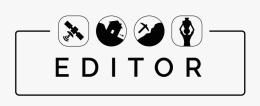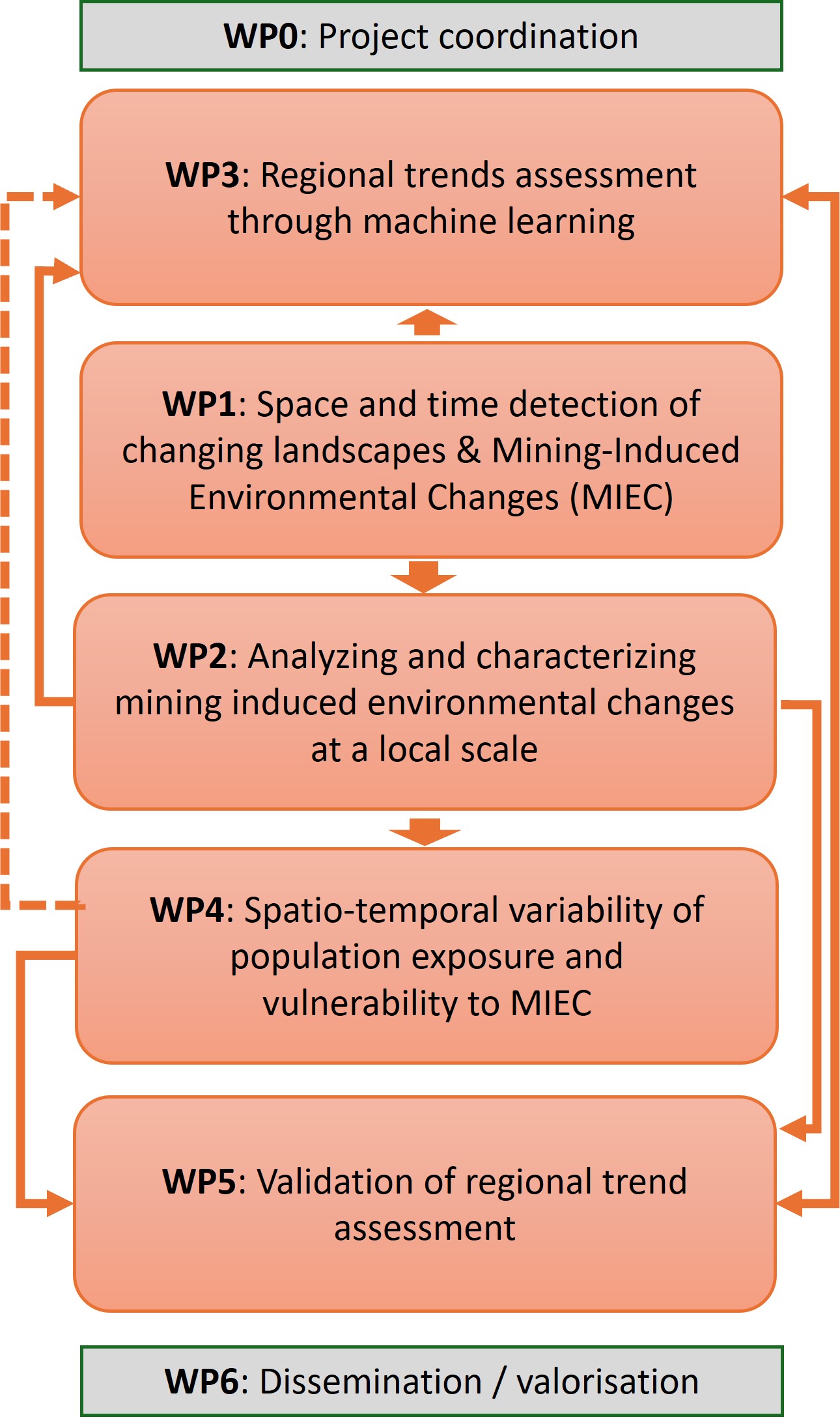EDITOR
Environmental hazards associated with mining activities in the tropics: a holistic risk approach from Eastern DR Congo

Using advanced Earth Observation techniques, the EDITOR project (2024-2029; STEREO IV) seeks to assess the extent to which mining activity and its related landscape disturbance, including the settlement and growth of villages in its vicinity (the mine’s zone of influence), causes or amplifies the prevalence of geo-hydrological hazards that affect the environment. The project focuses on artisanal (ASM) as well as industrial mining (LSM), and assesses impacts through the mobilisation of soil and rock, the creation of unstable slope conditions, downstream sedimentation, or the input or concentration of toxic substances used used in mineral processing; all in densely populated areas.
EDITOR draws on the wide range of expertise within the consortium in the use of satellite multi- and hyperspectral as well as radar imagery and their derivatives, and optical high resolution images. It also includes proven knowledge of the mechanisms leading to geo-hydrological hazards in tropical environments, as well as ground- and lab-based expertise on the specific geological, mineralogical and societal contexts. Indeed, the project benefits from the expertise and methods in social sciences required to assess the vulnerability of populations exposed to mining-induced environmental changes. EDITOR relies on existing scientific activities and brings together a network of researchers and field-expert partners anchored in relevant Congolese scientific institutions within the studied region. Processing this considerable volume of data requires enhanced capabilities of machine learning (ML) techniques, enabling the construction of an automatic tool for detecting and monitoring environmental changes, whether or not induced by human activity.
This 5-year project is funded by the Belgian Science Policy Office (BELSPO) under the STEREO IV programme and is coordinated by the Royal Museum for Central Africa, in collaboration with the Centre Spatial de Liège (CSL), the University of Twente’s Faculty of Geo-Information Science and Earth Observation (ITC), and the Institute of Development Policy at the University of Antwerp (UAntwerp).
The EDITOR kick off meeting was organised on June 6, 2024 in Bukavu (DR Congo), in the presence of the partner institutions (CEGEMI, CIRRINA and SGN) and the stakeholders involved in the study of environmental change in general, and in mining environments in particular. Watch the video below (thank you, Sara)!
Context & Objectives
Global climate change commitments and the rapid implementation of ‘green’ technologies transition lead to a major increase in demand for raw materials, and associated increase in commodity prices. This scramble for natural resources has led to a ramp up in (often unregulated) mining activities, both industrial and artisanal. Mining activities disturb the landscape directly at the mining sites: open cast pits and excavated land, waste piles, hillslope cuts and processing plants. They also lead to off-site changes, sometimes kms away, such as road constructions, development of new housing areas, deforestation and agricultural shifts. Mining activities are also associated with health issues (pollution of sediments and rivers, contamination of soil and food crops, dust pollution). Overall mining activities lead to societal and demographic shifts, influencing the vulnerability of the exposed population to geo-hydrological hazards.
EDITOR aims to address the issue of environmental changes related to increased mining activities driven by global demand for metals, notably in the context of global climate change commitments and implementation of ‘green’ technologies, and mining-related social impacts, such as rapid demographic increase and land use changes, which so far remain either understudied or possibly underestimated in the targeted region (eastern DR Congo). In the perspective of sustainable exploitation of critical metals to cope with their exponential use, this approach is fundamental to effectively consider the interests and priorities of the populations and countries concerned.
The Specific Objectives of the project are:
- SO-1: To detect, in space and time, mining induced environmental changes (MIEC)
- SO-2: To analyze and characterize the detected MIEC at the local scale
- SO-3: To assess the regional trend in MIEC using a machine learning approach
- SO-4: To characterize the spatio-temporal variability of the population exposure and vulnerability to MIEC

Study region

The targeted area is the eastern part of DRC, known for its concentration of geological resources, particularly critical minerals such as cobalt, copper, tin, coltan and gold. This region is characterized by a high density of different types of mining sites, involving a large population that is directly or indirectly dependent on mining for income, as well as directly or indirectly affected by its environmental and social consequences.
Artisanal and semi-industrial mining of coltan, gold and tin is generally achieved from soft and shallow surface deposits, via open pit excavations and digging offhand-dug holes in the soft sedimentary cover, without the use of modern machinery. Recovery of the minerals typically only requires the use of water, to separate the dense ore minerals from the lighter waste material, thus increasing the sediment load of rivers and potentially contaminating local streams and water supplies. Artisanal gold mining also involves the use of mercury, which is subsequently released to the environment. Only in the industrialised Katanga region, copper and cobalt are extracted from hard rock in large open pits, or deep underground tunnels, and concentrated using more advanced techniques, to then be sold as concentrate or smelted in local refineries. Large open cast mines such as the Komoto mine occur directly alongside large and densely populated cities such as Kolwezi and Likasi.
The region as a whole is also known for the critical prevalence of geo-hydrological hazards regularly affecting households and infrastructures, especially during rainy seasons. All these interdependent factors foster environmental changes at mining sites, but also far beyond, sometimes with considerable consequences in terms of natural resource availability.
Activities
EDITOR is based on 4 main pillars:
- the complementarity of the different teams involved in the consortium and the presence of two dedicated PhD students,
- the availability of valuable data including valuable archive from the RMCA and ancillary data - both past and present,
- the exploitation of synergies from passive optical (multi- and hyperspectral) and active radar satellite sensors (different modalities in terms of wavelength, polarization and viewing geometries),
- a solid network of scientific collaborators in the region of interest who are the experts in the field.
The EDITOR project is articulated around 5 complementary Work Packages, feeding each other as presented in the conceptual framework (Figure 3).

Some references on which the project is built
Banza Lubaba Nkulu, C., Casas, L., Haufroid, V., De Putter, T., Saenen, N.D., Kayembe-Kitenge, T., Musa Obadia, P., Kyanika Wa Mukoma, D., Lunda Ilunga, J.M., Nawrot, T.S., Luboya Numbi, O., Smolders, E., Nemery, B., 2018. Sustainability of artisanal mining of cobalt in DR Congo. Nature Sustainability 1, 495–504. doi:10.1038/s41893-018-0139-4
Deijns, A.A.J., Dewitte, O., Thiery, W., D’Oreye, N., Malet, J.-P., Kervyn, F., 2022. Timing landslide and flash flood events from SAR satellite: a new method illustrated in African cloud-covered tropical environments. Natural Hazards and Earth System Sciences 22, 3679–3700. doi:https://doi.org/10.5194/nhess-22-3679-2022
Depicker, A., Govers, G., Jacobs, L., Campforts, B., Uwihirwe, J., Dewitte, O., 2021a. Interactions between deforestation, landscape rejuvenation, and shallow landslides in the North Tanganyika-Kivu rift region, Africa. Earth Surface Dynamics 9, 445–462. doi:10.5194/esurf-9-445-2021
Depicker, A., Jacobs, L., Mboga, N., Smets, B., Van Rompaey, A., Lennert, M., Wolff, E., Kervyn, F., Michellier, C., Dewitte, O., Govers, G., 2021b. Historical dynamics of landslide risk from population and forest-cover changes in the Kivu Rift. Nature Sustainability 4, 965–974. doi:10.1038/s41893-021-00757-9
Dewitte, O., Dille, A., Depicker, A., Kubwimana, D., Maki Mateso, J.C., Mugaruka Bibentyo, T., Uwihirwe, J., Monsieurs, E., 2021. Constraining landslide timing in a data-scarce context: from recent to very old processes in the tropical environment of the North Tanganyika-Kivu Rift region. Landslides 18, 161–177. doi:10.1007/s10346-020-01452-0
Dille, A., Dewitte, O., Handwerger, A.L., D’Oreye, N., Derauw, D., Ganza Bamulezi, G., Ilombe Mawe, G., Michellier, C., Moeyersons, J., Monsieurs, E., Mugaruka Bibentyo, T., Samsonov, S., Smets, B., Kervyn, M., Kervyn, F., 2022. Acceleration of a large deep-seated tropical landslide due to urbanization feedbacks. Nature Geoscience 15, 1048–1055. doi:10.1038/s41561-022-01073-3
Geenen, S., Stoop, N., Verpoorten, M., 2021. How much do artisanal miners earn? An inquiry among Congolese gold miners. Resources Policy 70, 1–30. doi:10.1016/j.resourpol.2020.101893
Maki Mateso, J., Bielders, C.L., Monsieurs, E., Depicker, A., Smets, B., Tambala, T., Bagalwa Mateso, L., Dewitte, O., 2023. Natural and human-induced landslides in a tropical mountainous region: the Rift flanks west of Lake Kivu (DR Congo). Natural Hazards and Earth System Sciences 23, 643–666. doi:https://doi.org/10.5194/nhess-23-643-2023
Michellier, C., Pigeon, P., Kervyn, F., Wolff, E., 2016. Contextualizing vulnerability assessment: a support to geo-risk management in Central Africa. Natural Hazards 82, 27–42. doi:10.1007/s11069-016-2295-z
Nkuba, B., Bervoets, L., Geenen, S., 2019. Invisible and ignored? Local perspectives on mercury in Congolese gold mining. Journal of Cleaner Production 221, 795–804. doi:10.1016/j.jclepro.2019.01.174
Consortium


